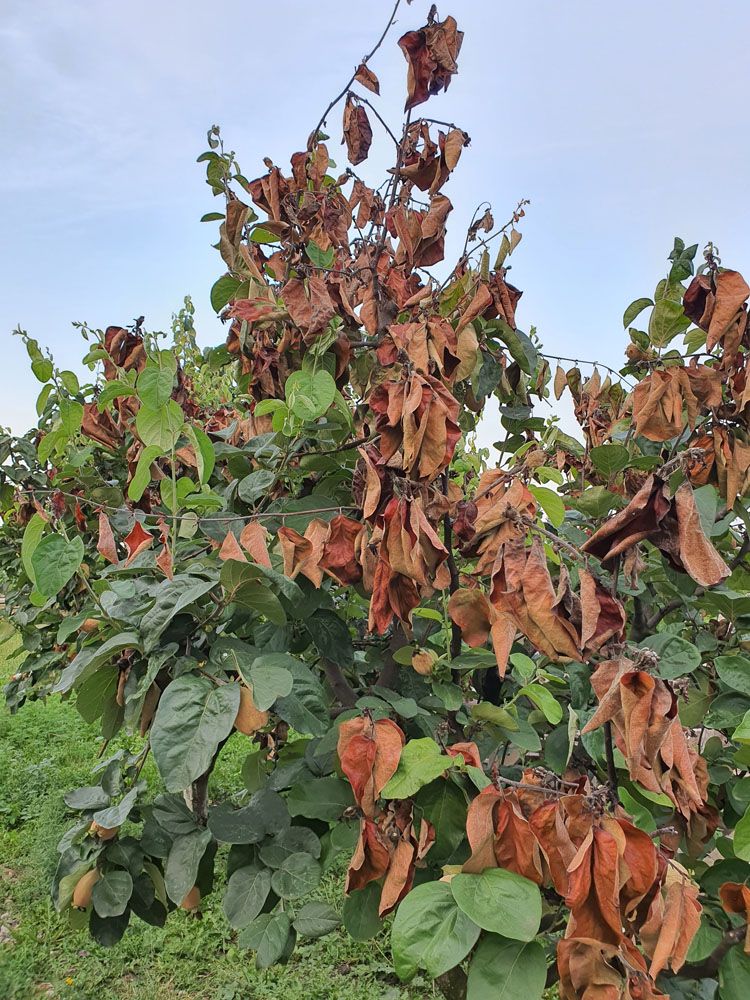
Fire Blight
Fire blight (Erwinia amylovora)
Erwinia amylovora is a native bacterium of wild, rosaceous hosts in eastern North America. It was the first bacterium that was identified as a plant pathogen. In many regions of the world, fire blight is still a major problem with apples and pears.
What is Fire blight?
Fire blight is a dangerous, highly infectious, and pervasive infection caused by the bacterium Erwinia amylovora. In Georgia, fire blight may be an issue, and it is persistent in specific counties. Blossoms, leaves, shoots, branches, fruits, and roots are all affected by fire blight. The facts and procedures for avoiding and controlling the disease are presented in the following paragraphs.
Symptoms:
Fire blight symptoms can occur as soon as trees and shrubs begin active growth. The first symptom of fire blight is a light tan to reddish, watery slime emanating from the diseased branch, twig, or trunk cankers. After exposure to air, the ooze darkens, forming black stripes on the branches or trunks. Infections of fire blight spread from infected blooms to twigs and branches. Twigs shrivel and blacken, frequently curling at the tips, while blossoms become brown and fade. Cankers occur on branches in more severe cases of fire blight infection. Fire blight bacteria are present in large numbers in these discolored oozing areas, resulting in fatal diseases.
Life Cycle:
The disease usually penetrates the tree through natural openings, such as blossoms and wounds in the spring. Fire blight swiftly spreads from the current season’s growth into older growth after establishing itself in the tree. Rain, wind, and pruning tools can transfer fire blight from infected to healthy plants. The bacteria can survive the winter in infected branches’ deep cankers. The germs seep out of the cankers in the spring, attracting bees and other insects. Insects also aid in the disease’s spread to healthy plants. In warm temperatures (65 degrees F or higher) and humid conditions, the bacteria spread quickly through the plant tissue.
How to fire blight spread?
Fire blight bacteria are spread quickly through different means such as rain or water splashing, insects and birds, other diseased plants, and unclean gardening tools. As it emerges from hibernation in late spring or early summer, these bacteria pose the most significant risk of infection. Currently, there is no treatment for fire blight. Regular pruning and removal of any affected stems or branches are hence the best fire blight treatments. It might also help minimize overhead watering, one of the most prevalent routes for the virus to spread.
Control:
Seasonal weather has a significant impact on the development of fire blight. Conditions are excellent for disease growth when temperatures range from 75 to 85 degrees Fahrenheit and are accompanied by occasional rain or hail. Rapidly developing trees’ succulent tissue is susceptible. Heavy trimming and excessive nitrogen fertilizer should be avoided. During flowering, trees should not be watered. Apply blossom sprays to prevent new infections if fire blight has been a problem in the past.
Selecting Tolerant Plants:
The majority of pear tree cultivars are prone to fire blight. Fruit trees that bloom late in the season or all year (such as rat-tail bloom) are prone to fire blight. Plant cultivars that are less susceptible to fire blight damage wherever feasible.
Getting Rid of Diseased Wood:
When the bacteria aren’t propagating through the tree, it’s easier to get rid of fire blight infections in the summer or winter. Conditions have stopped growing at this point, canker edges are apparent, and cleaning pruning shears is no longer essential. Between cuts, clean pruning shears with a 10% bleach solution. The cut’s location is significantly more crucial than the instruments’ cleanliness. If a trunk or large limb becomes infected with fire blight, the timber can be preserved by scraping off the affected bark.
Chemical Control:
Copper is the sole substance that can be used to combat fire blight. Even with several applications, they frequently fail to offer appropriate control. Because the spray must be administered to open blooms, the number of treatments required is determined by the duration of the bloom period. Copper compounds may also cause the surface of the fruit to become rusted or scarred. The danger of injury starts during bloom and grows as the fruits become larger. SERENADE Garden is a broad-spectrum, preventive bio-fungicide that may be used to manage or suppress a wide range of plant diseases. Treat foliar disease before it develops or at the first indication of infection for the most excellent outcomes. Repeat the process every seven days or as required.
